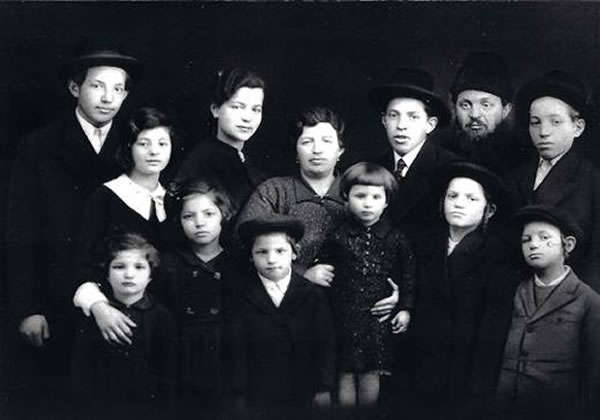In Bergen-Belsen, 1945, 19-year-old Amram Deutsch risked his life every morning to put on tefillin and recite the Shema underneath his barracks before roll call.
Knowing that his life was in danger either way, he decided it was worth the risk to perform this mitzvah. “I couldn’t believe I had this opportunity, even though I realized I could lose my life. We were very fortunate we were not caught.”
How he came by the prayer phylacteries in a concentration camp is part of Deutsch’s amazing story of survival in hell.
He and the other prisoners slept like sardines crowded in bunk beds. To endure the winter cold they huddled like one body trying to share warmth. One of his bunkmates whispered, “Amram, I’m going to tell you a secret. Under the barracks are tefillin. We have two minutes to say the Shema and put the tefillin back.”
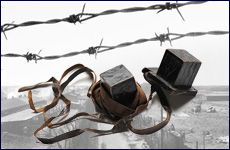 Kapos looked through luggage and saved valuables like tefillin, prayerbooks, gold and watches.
Kapos looked through luggage and saved valuables like tefillin, prayerbooks, gold and watches.
The kapo who supervised the prisoners had been a family friend of Amram’s bunkmate before the war. Thanks to this connection, the bunkmate had access to the tefillin.
How did the kapo manage to have tefillin in a concentration camp? As Deutsch explains, when new trainloads of Jews arrived, kapos were able to look through luggage and save valuables – like tefillin, prayerbooks, gold and watches – that they wanted to hide. A prime hiding spot was the quarantine area which was rife with disease.
The kapo, who was also putting on tefillin under the barracks, told the young men how to follow his lead so nobody would catch them praying. Amram and his bunkmate were to get up while everyone was still sleeping and pretend they were going to the bathroom outside. “My bunkmate went first; I gave him three to four minutes. Then when he came back, I left the bunk to put on the tefillin,” says Deutsch.
With typical German efficiency, everything in Bergen-Belsen was measured in minutes. Prisoners never undressed or took off their shoes when they went to bed. When awakened in the morning they had two minutes to go to the bathroom before roll call and labor.
The severely overcrowded concentration camp was a pit of dead and dying prisoners who suffered starvation and diseases like typhoid fever. “You have to understand what it is to come out from hell and be able to talk about it,” the 92-year-old Holocaust survivor who now lives in Los Angeles told Aish.com.
German Occupation
A cousin of Elie Wiesel, Deutsch grew up the seventh of 11 siblings in a religious family in Sighet, Transylvania, then part of Romania. In 1939 he was 14 years old and didn’t yet realize the world was “on fire.” His family and neighbors lived in relative isolation, with no radio, no telephone and no electricity.
Jewish homes were boarded up. We were taken to the ghetto.
“Hitler occupied Transylvania the day after Passover in April 1944. Until then I had no idea that Jews were being killed,” Deutsch says. “Every able man had to leave his house, not knowing the reason. That’s how we found out we were occupied by Germans.
The family of Amram's son, Jack
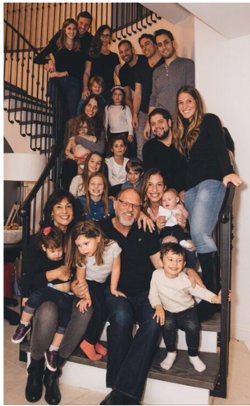
“We had no idea that a few days later the whole family left for the ghetto. After five weeks we were ordered to go back home. We realized all the Jewish homes were boarded up. We were taken to the ghetto where people were crying. They didn’t have food, they were mistreated.”
In May the Germans evacuated the Jews from the ghetto and crammed them into a train with only room for them to stand. Deutsch estimates about 130 adults and children were pushed into his dark, windowless cattle car.
Old people passed out. Babies choked to death from the smell.
The clueless passengers had no food or water for 4 ½ days, only two large drums that served as toilets. Old people passed out. Babies choked to death from the smell. The horrible memory haunts Deutsch to this day. “Whenever I hear a cry now, it tears my kishkes up.”
The darkness of that trip, in which they didn’t know if it was day or night, foreshadowed what came next.
Living in darkness
The train pulled into Auschwitz where a large blinding light greeted new arrivals. Nobody had told the passengers where they were going or why. They lived in the dark, not knowing what was going to happen to them. They wondered what the chimneys were that they saw – maybe factories? Everyone on the train dispersed and disappeared, without a chance to say goodbye.
On the second day Deutsch and others began to ask questions about their fate. He learned his parents and sister had been murdered in the gas chamber. He spotted his 16-year-old brother Sruli in Auschwitz the next day but barely recognized him because everybody’s hair had been cut off. Sruli disappeared two days later.
“Every day you would see dead people around the fences. They didn’t want to continue to live. The Germans told us there’s no way anyone will leave Auschwitz except from the five chimneys.”
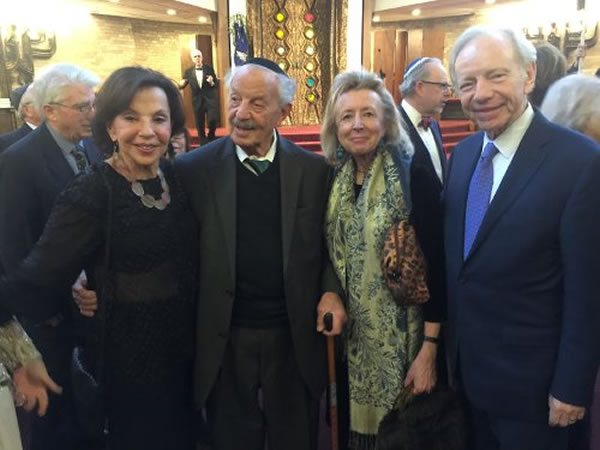
After nine days waiting to find out what he was doing there, Deutsch was sent to the slave labor camp Buna-Monowitz, another branch of Auschwitz. For six months he worked as a barber to cut prisoners’ hair to help manage lice problems in the camp. That entitled him to extra rations of soup and bread which helped him survive.
“I was a barber when I was 9 years old. My mother asked me to cut my brother’s hair with hand clippers. That’s how I became a professional barber.”
Meanwhile, Russian troops were fighting the Germans. In January 1945 the Germans evacuated their prisoners, forcing them to walk on a death march from Buna for three days in sub-zero weather.
They wound up at Sachsenhausen-Oranienburg, a concentration camp north of Berlin. From there, the Germans selected able-bodied people for transport in an open train for two days. As Deutsch recalls, "We survived eating the snow.” Wearing only thin uniforms, half of the prisoners froze on the train.
We decided to lie down among dead bodies in the barracks. That’s how we survived.
The prisoners were returned to Bergen-Belsen. “When we walked in from 2 ½ days on an open train, we realized there was no life. That’s why they called it a death camp. Survivors worked to pick people off the street.
“Nobody was in the towers. The camp was locked up. We decided to lie down among dead bodies in the barracks. That’s how we survived.”
A 64-pound living skeleton
The Allies liberated Bergen-Belsen April 12, 1945. Deutsch weighed only 64 pounds and was semiconscious.
British soldiers dispatched him to a Catholic hospital in the nearby town of Celle, where he stayed 4 ½ months. The nuns removed and burned his lice-infested clothes. The dirt was caked on his body and took a few weeks to clean up by bathing in a tub of lukewarm water.
Deutsch says, “We never took a shower for one whole year. When it rained, we shook some lice off our body. People don’t understand what it’s like to live through the Second World War and to talk about it. Some of us didn’t have any shoes. We had rags on our feet.”
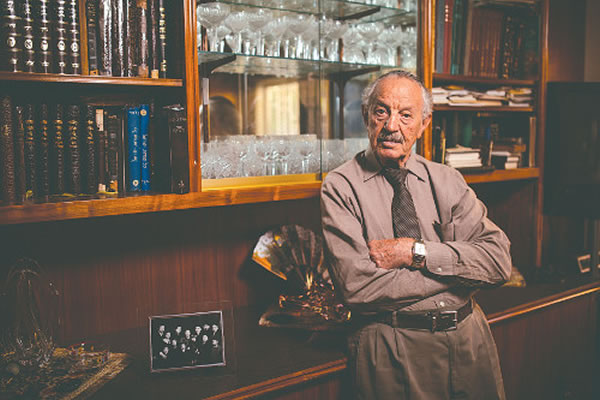
Slowly he grew stronger. After 4 ½ months he left the hospital not knowing where to go, so he returned to Bergen-Belsen after learning that a cousin, Lili, was in the women’s camp. He stayed in the military barracks there. On Jan. 1, 1946, the two married and had the whole camp as wedding guests.
Their daughter, Mindy, was born in the displaced persons’ camp where the family remained until emigrating to America in 1949. Deutsch worked at several bakeries in New York and Los Angeles and retired in 1990.
He has served as gabbai of Congregation Bais Naftoli in Los Angeles since 1991, and gets up early every morning to open the shul in time for people to pray.

The father of two, grandfather of eight and great-grandfather of 17 speaks two or three times a week at the Museum of Tolerance. “I appreciate that I am able to do it and inspire a lot of people who hear my story. A little luck and not giving up – that’s how I survived. God helped me succeed to be a witness to the world what really happened in World War II. The generation today should not forget.”
Deutsch looks forward to celebrating Purim with the congregants and children of his shul. He draws a parallel between Haman and Hitler. Both died – the former by hanging and the latter by suicide – before they could wipe out Jews from the face of the Earth.
“Hitler didn’t succeed. I outlived him. He lost his life, and the Jews are still here.”
[Published on Aish.com, February 24, 2018]

